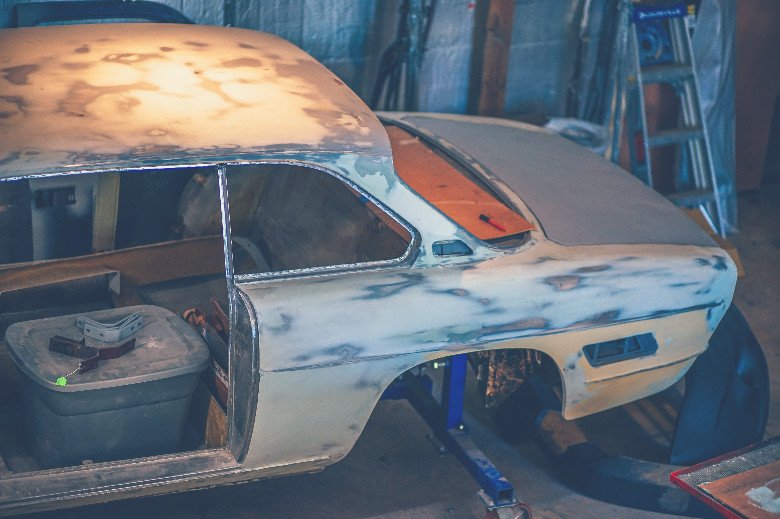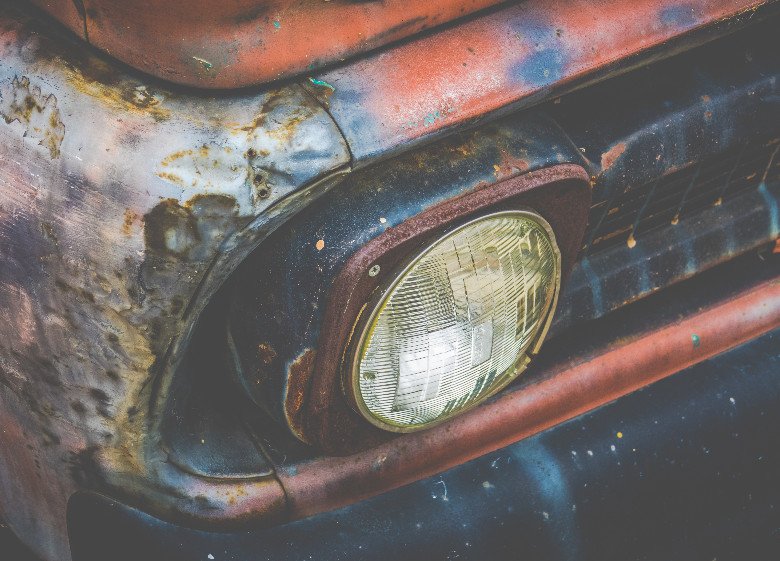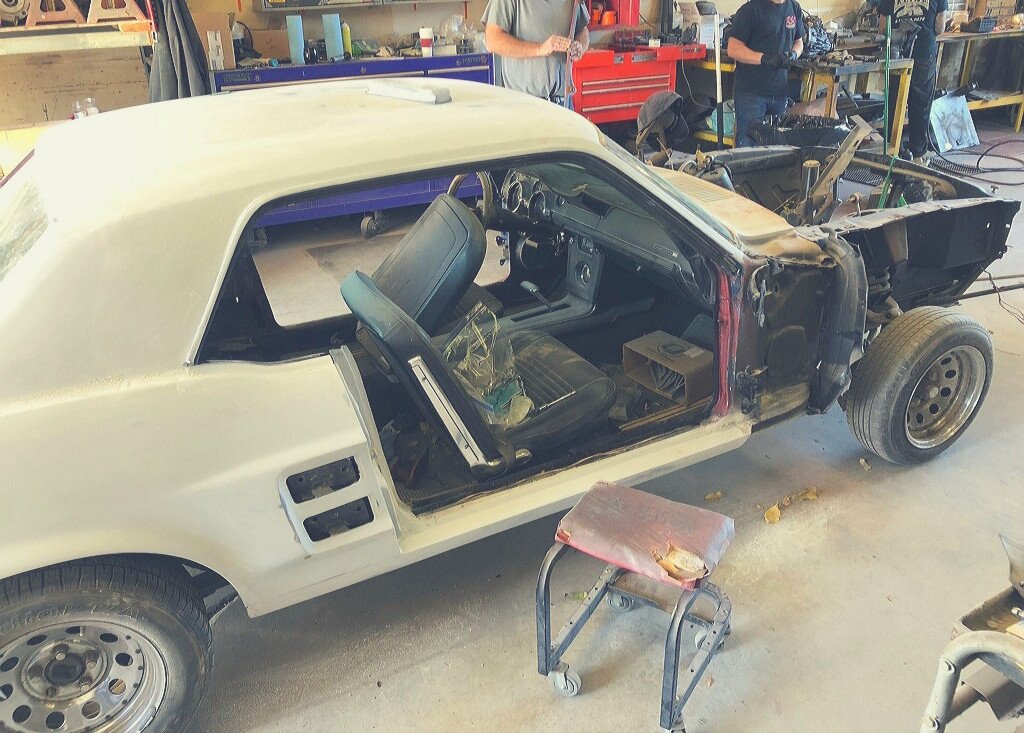Have you ever walked out to your car and wondered what that funny little thing was on the rocker panel?
Then discover that it’s rust?
Your first instinct may be to buy a new car. Then you look at new car prices.
Your next thought is probably a body filler.
All brands and types are often erroneously referred to as Bondo. It’s a popular way to make small repairs without suffering through the expense of replacing an entire panel.
There are pages and pages of online jokes about “Bondo.” The truth is that it’s a great solution to small problems. Why pay to replace the entire rocker panel and a paint job for a small one square inch of rust?
Of course, you want to make sure that you use the best possible product and apply it correctly.
I may not be able to explain all the different ways to apply and use body filler in such a short space. But I can recommend some of the best body fillers.
Maybe you need a body filler for a rusty panel or even a wood application. Perhaps you have a fiberglass body or a marine application that’s waterproof. I’ll give you the low-down on body fillers and which will work best for each application.
Bondo Body Filler
Well, speak of the devil. If it isn’t Bondo.
Bondo is a brand name and not the name of the product, which is known as a body filler. Bondo simply happens to be the biggest and best known name, so everyone uses it.
This Bondo will be a salmon color when cured if that matters to you. It’s the original two-part formula. The filler will begin to thicken in 10 to 15 minutes when mixed. It should be fully cured within 30 to 40 minutes depending on the temperature and humidity levels.
This fast-acting filler means you don’t have to wait overnight for the product to cure. You can begin to sand it soon after it has been applied. Bondo is also very easy to sand and leaves behind a smooth finish.
The world loves Bondo because it works on more than just metal car bodies. You can use this lightweight filler on wood beams, tiles, bathtubs, Jacuzzi’s, and more.
Some users have complained that this product seems different somehow than the Bondo of the past. But I’ve used this product with excellent results no matter which size I have purchased.
Preparation of the surface is everything. Be certain that the surface is ready to accept Bondo filler or you won’t have the good results you are hoping for.
Bondo Hair Reinforced Filler
I know I said that the Bondo product above works for wood and other surfaces. That is true. But why not use a product that is made specifically for those applications?
This body filler has one-inch pieces of fiberglass which makes it lightweight and very durable.
Bondo states that this product has twice the strength of their standard car body filler.
This body patch is ready to sand in as little as 20 minutes. You can trust this lightweight filler on your most difficult repair jobs. Great examples include portions of rotten wood beams that would be difficult or expensive to replace, or rebuild part of a missing cabinet door.
As good as this product is, some users state that it became hard too quickly and was extremely sticky. This does cure in 20 minutes, which means you will need to work fast. I find that mixing small batches makes things go much smoother.
You should also always be aware of the outside temperatures when mixing body fillers. Always mix them according to directions.
If you’re a beginner, you might want to try the Bondo Body Filler 00261 that we mentioned above. This allows you a bit more drying time. Once you’ve gotten the hang of it, this product is ready to tackle your biggest wood repair job.
Bondo Glass Reinforced Filler
While body filler certainly has a variety of uses, perhaps the most common application is for body repair that has rust.
It’s designed to cover small holes of 1/2 inch or smaller without the need for backing strips or cloth.
One of the problems many people have with car body fillers is that they apply it directly to the rusted portion of the car. They expect the product to not only stick but to stop the rust from continuing.
Car body filler does not work this way.
You must remove the rust and get down to the bare steel or metal. If there is very little metal left after you do this, you are better off cutting off the damaged part and patching it with a new piece. Then use the car body filler to smooth it out.
If you fail to remove the rust, your repair will most likely crack and then fall off once the rust eats through.
How embarrassing would that be?
Some users complain that this car body filler contains too much flex and it causes a crack in the panel over time.
Do the proper preparation. That includes removing all the rust from the panel. Bondo Glass Reinforced Filler will leave you with a smooth finish you can be proud of.
NAPA also has a good read about working with body filler.
USC Duraglass Fiberglass Filler
If you are interested in a lightweight body filler that is waterproof, you can’t go wrong with Duraglas.
The honest truth is that no body filler will be 100 percent waterproof for life. Duraglas contains resin technology combined with fiberglass fibers. But no one can avoid pinholes too small for the naked eye to see.
These very small pinholes will let a tiny amount of water to get behind the filler. It is always best to replace any rusted portions with new metalwork. Then smooth over the rest using Duraglas, then primer, and then finally paint.
Duraglas is a premium, lightweight filler that every professional will recommend. Use it on boats, water tanks, and other applications where you want a waterproof seal.
This lightweight filler is easy to sand and comes with its own cream hardener. You don’t need to guess if you are using the correct hardener.
By the way, this product isn’t restricted to a metal body or fiberglass filler repair. It also works well on plastic pieces or cracks in other types of material.
No product is perfect. Even Duraglas has some negative comments from users who stated that the product is difficult to work with.
Ask any professional. They will tell you that for a waterproof body filler, you can’t beat Duraglas.
If you’re restoring a classic car, you’re bound to run in to rust. You may need a waterproof filler as well.
The guys over at the HAMB have a good discussion going on about dealing with rust and waterproofing.
Evercoat Everglass Short Strand Fiber Reinforced Filler
Many of the fillers I talked about above will work on fiberglass. But there is one product that is made especially for fiberglass: Evercoat Everglass.
This premium and lightweight product works well for patching fiberglass car panels or your fiberglass hot tub.
Most body armor that police use is made from Kevlar. Short strands of Kevlar are embedded in the product. That makes this one of the strongest, yet lightweight fillers available today.
Evercoat Everglass is dark green with a blue hardener. It can sometimes be difficult to tell if the product is properly mixed.
Speaking of mixing, you should have the surface completely prepped and ready to go. This one dries super fast! Depending on the temperature and humidity, this could dry within 10 minutes. So mix very small amounts and work fast!
It’s also a very thick product so take extra care to put it on as smoothly as possible. You want to avoid spending large amounts of time sanding it.
For those who are working on custom projects where galvanized steel or where plastic meets fiberglass, you won’t find a better filler.
Like all specialty fillers, this one is not without its complaints. The majority of complaints appear to be about dented cans when the product arrives.
Some say it dries so fast that it was difficult to work with.
If you want a filler that is rock hard, you want Evercoat Everglass with Kevlar.
What body filler do the pros use?

This is difficult to pin down. It’s like asking 100 different people which car model or even which car make is best! Everyone has an opinion depending on the application.
Ask professionals and one name you are bound to hear over and over is Bondo. Whether it’s Bondo 261 or the Bondo Hair with Long Fiberglass Fibers, these names come up over and over again.
If you speak to those who work in boatyards, you might hear the name Duraglas. It is the best nearly waterproof body filler.
Evercoat products are also commonly mentioned.
The product that is the best will depend on the application you want it for and your own draw to a certain brand.
If you read carefully, you will surely find the best product for whatever it is that you are working on.
What is the strongest body filler?
Evercoat Everglass Reinforced Filler is the strongest and hardest body filler around.
It’s reinforced with the same product used in body armor, Kevlar. This is still a lightweight body filler that is, well, hard as a rock! Try it once and you will see what I mean!
If fiberglass reinforced fillers are stronger than regular plastic-based fillers, then a Kevlar fiber embedded filler must really be extra strong.
Don’t get me wrong, fiberglass fibers are excellent since they do not absorb water. Technically Kevlar fibers will absorb some water, but only if they are exposed. Once they are embedded into the filler, they are every bit as waterproof as fiberglass.
Many boats and kayaks today are made from a sandwich of fiberglass and kevlar and held together with resin.
Kevlar is the stronger material and it’s lighter than fiberglass pound for pound.
But since Kevlar is stronger, this means it is the devil to sand and smooth. You should work in very small batches and try to smooth the product out before it hardens.
Kevlar is also more expensive than fiberglass. The best always costs more, right?
Don’t forget to wear the proper protective gear when sanding! Dust from body fillers, whether they are plastic, fiberglass, or Kevlar, is not good for the lungs.
Is Bondo body filler any good?

Yes, Bondo is an excellent product.
The problem with the Bondo name is that it is commonly used to refer to all types and brands of body filler. Even whether it is a Bondo product or not.
This means that even the cheapest junk body filler will be called Bondo. This unfortunately means that the Bondo name gets dragged through the proverbial mud when the product fails.
This is similar to the way that cotton swabs are all called Q-Tips and tissues are often called Kleenex. Q-Tip and Kleenex are brand names, not the name of the actual product.
Of course, you might find some who don’t happen to like the Bondo brand of products. That’s their opinion and they are entitled to it.
But if you find a better product than Bondo, you should use it.
Bondo was introduced in 1955. The original formula, 00261, is still the number one, best-selling body filler today.
That’s nearly 70 years of being number one. Bondo must have something going for it!
Does body filler last long?
This is another difficult question. Does a pair of shoes last long? That would depend on what they were used for, what they were made from, and how well they were taken care of, correct?
The same is true of body filler.
Making body filler last longer depends on the application and how it was applied. For example, body repair on a classic car that mostly sits or a water tank that is left outside in extreme temperatures. One will last longer than the other.
Prepping the surface is of the utmost importance. A surface that is dirty, rusty, or contains contaminants won’t allow the filler to stick properly.
It can last for decades when the surface is properly prepared. The filler must be added in a sufficient amount but not to excess. It should be properly sanded, primed, and painted. That’s how you get it to last a long time.
Also, the quality of the filler will matter. Shoes from the dollar store won’t last more than a few outings right?
The same is true with fillers. A super cheap filler with no name or an unknown name will give you unsatisfactory results.
A poor job in any of the above workmanship areas can give bad results. It can mean that the filler will crack or even have small chunks fall off, in a matter of months.
How do you apply body filler smoothly?

This is something that takes practice. But if you are careful, even a beginner can pull off a basic body repair.
Make sure that the surface is well-prepped. Be sure that your surface is clean of dust and grease, and that it is fairly flat. Use a straightedge if you must.
Apply a base coat of epoxy primer and then use fine sandpaper to feather out the edges of the paint.
How much of the product you will mix will depend on the size of the repair and how fast the product cures. For an average-sized repair, try mixing up an amount that would equal a typical sandwich on white bread.
Applying the filler smoothly is something like icing a cake. You should wipe or sweep from side to side, don’t dab at it or slap on a big glob.
Unfortunately, you don’t have a great deal of time to play with most products, so put it on and get to work fast!
Body Filler Tips
In Conclusion
Body filler isn’t nearly as complicated as it sounds. Do your prep work, pick a quality product, and you will be surprised at how well your project turns out!






